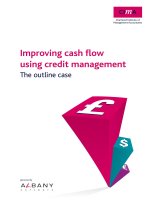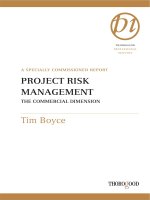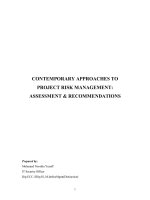PROJECT RISK MANAGEMENT: THE COMMERCIAL DIMENSION docx
Bạn đang xem bản rút gọn của tài liệu. Xem và tải ngay bản đầy đủ của tài liệu tại đây (4.17 MB, 147 trang )
A SPECIALLY COMMISSIONED REPORT
PROJECT RISK
MANAGEMENT
THE COMMERCIAL DIMENSION
Tim Boyce
THOROGOOD
PROFESSIONAL
INSIGHTS
THOROGOOD
PROFESSIONAL
INSIGHTS
A SPECIALLY COMMISSIONED REPORT
PROJECT RISK
MANAGEMENT
THE COMMERCIAL DIMENSION
Tim Boyce
Published by Thorogood
10-12 Rivington Street
London EC2A 3DU.
t: 020 7749 4748
f: 020 7729 6110
e:
w: www.thorogood.ws
© Tim Boyce 2003
All rights reserved. No part
of this publication may be
reproduced, stored in a retrieval
system or transmitted in any
form or by any means,
electronic, photocopying,
recording or otherwise, without
the prior permission of
the publisher.
This Report is sold subject to the
condition that it shall not, by way
of trade or otherwise, be lent,
re-sold, hired out or otherwise
circulated without the publisher’s
prior consent in any form of
binding or cover other than in
which it is published and without
a similar condition including this
condition being imposed upon
the subsequent purchaser.
No responsibility for loss
occasioned to any person acting
or refraining from action as a
result of any material in this
publication can be accepted by
the author or publisher.
A CIP catalogue record for
this Report is available from
the British Library.
ISBN 1 85418 257 9
Printed in Great Britain
by printflow.com
Other Thorogood
Professional Insights
Techniques of Structuring and
Drafting Commercial Contracts
Robert Ribeiro
Successful Competitive Tendering
Jeff Woodhams
The Legal Protection of Databases
Simon Chalton
The Internet and E-Commerce
Peter Carey
Technical Aspects of Business
Leases
Malcolm Dowden
The Commercial Exploitation
of Intellectual Property Rights
by Licensing
Charles D. DesForges
The Competition Act – Practical
Advice and Guidance
Susan Singleton
Special discounts for bulk quantities
of Thorogood books are available to
corporations, institutions, associations and
other organisations. For more information
contact Thorogood by telephone on 020
7749 4748, by fax on 020 7729 6110, or
e-mail us:
The author
Tim Boyce began his career in the Ministry of Defence holding executive positions
in contracts, contracts policy and finance. His industrial career began at Plessey
in 1980 after which he enjoyed appointments with Siemens, British Aerospace
and more recently as commercial director at BAE SYSTEMS. His functional
responsibilities have included contracts, commercial, procurement, estimating,
legal, project accounting and the implementation of the European Business Excel-
lence Model.
His committee work includes the Chartered Institute of Purchasing and Supply
National Contracts Management Committee, the CBI Contracts Panel, the CBI
Defence Procurement Panel and the CBI/MoD working groups on partnering
and incentive contracting. He was the CBI observer at the HM Treasury Central
Unit on Purchasing working group on incentivising industry. In 1997 he was
invited by the Director General of the CBI to join the CBI Public Private Partner-
ship Forum. He has lectured widely in the UK and in the US on business, contract
and commercial management.
THOROGOOD PROFESSIONAL INSIGHTS
Contents
1 TOTAL RISK MANAGEMENT 1
2 GETTING TO CONTRACT 8
1. The risk – risk scenario 9
2. The bid/no bid decision 9
3. Bidding 16
4. Pricing for risk 19
5. Risk review board 23
6. Making an offer 25
7. The priced list of risks 29
8. The caveats register 30
9. An effective contract 31
10. Negotiation 34
11. Contract launch 35
12. Pointers for project risk management 36
Checklist 36
3 FINANCIAL RISK 38
1. Prime contract financial risk 39
2. The nature of price and the sharing of cost risk 39
3. The client will not pay 43
4. The client cannot pay 46
5. Inflationary cost increases 46
6. Foreign currency fluctuations 48
7. Contract termination 51
8. Financial claims against the prime contractor 53
9. Pointers for project risk management 54
Checklist 55
4 TECHNICAL RISK 58
1. Do we want to take this risk? 59
2. Analysing the requirement 60
3. Options 60
4. Sharing the risk 61
5. The commercial engineer 62
6. Setting the baseline 63
7. Requirement creep 64
8. The changing requirement 65
9. The work takes longer than expected 66
10. The never-ending contract 68
11. Failure of performance 69
12. Buyer initiated problems 70
13. Pointers for project risk management 71
Checklist 72
5 TIMEFRAME RISK 74
1. Bidding compliant delivery 75
2. The timeframe obligation 78
3. Time is of the essence 79
4. Consequences of delay 79
5. Liquidated damages 81
6. Force majeure 81
7. Delivery incentives 83
8. Client delay 84
9. Subcontractor delay 86
10. Prime contractor delay 86
11. The threat of termination 88
12. The threat of damages 89
13. Pointers for project risk management 91
Checklist 92
THOROGOOD PROFESSIONAL INSIGHTS
6 SUBCONTRACTOR RISK 95
1. For the want of a nail 96
2. Subcontracting: Benefit, risk and strategy 97
3. Subcontractor lateness 104
4. Subcontractor failure 105
5. Subcontractor work unfit 106
6. Monitoring subcontractors 106
7. Pointers for project risk management 107
Checklist 108
7 PROJECT COMPLETION AND BEYOND 113
1. Life after completion 114
2. Key contractual milestones 114
3. Residual obligations and risks 117
5. Acceptance 118
6. Products rejected 120
7. Title does not pass 121
8. Products lost or damaged in transit 122
9. Failure after delivery/acceptance 122
10. Warranty 123
11. The hand over of technical data to the client 125
12. Third party intellectual property rights 127
13. Account management 129
14. Pointers for project risk management 130
Checklist 131
THOROGOOD PROFESSIONAL INSIGHTS
Section 1
Total risk management
THOROGOOD
PROFESSIONAL
INSIGHTS
Section 1
Total risk management
The basis of all business is buying and selling goods or services or a combina-
tion of the two. The word product is these days used for both goods and services.
A television is a product and a particular type of insurance scheme may be
described by the provider as a product. For the purposes of this Report the word
product will be used in the former sense. Products are designed and produced
and sold to customers as end items in themselves. The characteristics of a product
might include: it is available off-the-shelf; it is produced (hardware) or replicated
(software) in quantity with each unit being identical to every other; the design
is driven by the supplier (albeit aimed at specific markets) rather than by an
individual customer; the performance characteristics are well known prior to
the product being made available to customers; its constituent parts are readily
available as materials or components.
On the other hand there is a particular type of service which is called a project.
It commonly comprises the bringing together of many disparate products into
an overall solution. The characteristics might include that it is bespoke; it is unique;
the design is driven by one customer; performance characteristics can be designed
and modelled but not known until the project is complete; its constituent parts
may comprise products which themselves must be specially designed. Projects
tend to be of large financial size and long timescale. Whilst no business enter-
prise is without risk, it can be seen quite readily that projects are by their very
nature of considerably greater risk than products. Management of risk in a projects
environment is therefore of considerable importance.
Project Risk Management is a well established doctrine supported by many tools
and techniques. Risk analysis, risk registers, risk models and active risk manage-
ment are all important in seeking that ultimate goal of project management –
completion on time, to specification and within budget. There is, however,
another key distinction between products and projects, the significance of which
is perhaps sometimes overlooked. Products tend to be bought or sold subject
to standard terms of contract. The buyer or seller, usually whichever is in the
stronger position, subjects the transaction to his standard terms. In a percentage
of cases there may be some negotiation of these terms, but frequently not.
Conversely the prime contract terms for a project are invariably negotiated,
specially drafted and often of significant contention before the parties come to
agreement. Each side may come to the negotiation armed with a preferred set
2
THOROGOOD PROFESSIONAL INSIGHTS
of terms, some or all of which may be based upon standard terms. Each will
try to exploit the strength of its bargaining position to secure its terms but
ultimately the agreed terms will always be of a bespoke nature, reflecting not
only the outcome of commercial negotiations but in many instances reflecting
the fact that individual standard terms may simply not exist or may be inade-
quate for the unique situation of the particular project.
Interestingly the choice between buyer and seller standard terms in a routine
product transaction is fraught with danger for the side that concedes, for the
simple reason that standard terms are never generated with fairness or balance
in mind. The reason that every transacting organisation has different standard
terms for sale and for purchase is that each organisation expects to purchase
from its suppliers on terms which it would ideally never confer on its customers
and vice versa. The central reason is that each organisation likes to both buy and
sell at zero or minimum risk to itself. Standard terms are a means of pushing
risk ‘down’ to suppliers and ‘up’ to customers. Everyone in the supply chain has
the same motive. Of course in simple product transactions little attention is given
because nobody expects anything to go wrong. The product is identified by part
number or catalogue number, specifications exist, and price and payment are
straightforward. The client gets what he is expecting and the supplier gets his
money. The allocation of risk under the contract terms is of no practical interest
other than in the very small percentage of cases where things do go wrong.
Projects are different. It is not so much that the parties expect things to go wrong
(if they did, they have no business in proceeding) but that they are aware that
the risk of difficulty is inherently much higher. Not only are there usually more
risks but several of the risks may have a significant probability of arising and
the impact of a risk that materialises may be catastrophic. This results in two
things. Firstly, each side (preferably jointly) will consider how best to manage
the project so that risks do not materialise at all or, if they do, that the impact
is minimised. Secondly great attention is given to the negotiation of bespoke
contract terms. The contract is ultimately the single vehicle by which risks are
allocated (or shared) between the parties. It is essential that each party knows
where it stands both before a final decision is made to enter into the contract
and afterwards, if risks materialise.
A project management plan may ascribe responsibilities between the parties.
A risk management plan may purport to allocate individual risks to one party
or the other but the contract must be clear on what these allocations mean from
a legal perspective. This is not just a point of technicality. For example, if the
client agrees to carry responsibility for a particular risk (which affects the proba-
bility of timely completion of the project) and to undertake risk mitigation activities,
1 TOTAL RISK MANAGEMENT
3
THOROGOOD PROFESSIONAL INSIGHTS
where does that leave the prime contractor? Supposing the client neglects to
undertake the mitigation (perhaps to save money) and the project runs late, can
the prime contractor charge for his own increased costs? If the project runs late
because of this failure to mitigate, where does that leave the client? Can he still
terminate the prime contract for default (failure to complete on time) on the part
of the prime contractor? Common sense or a sense of fair play may incline the
reader towards one answer or another, but common sense and fair play are
unfaithful guides. The answer of course is that what happens in the real world
of project management and active risk management cannot be divorced from
the hard questions of liability and the consequences of doing or not doing
something.
So, the prime contract is the ultimate risk vehicle. Pre-contract negotiations will
have established an allocation of risks enshrined in the prime contract. The form
of contract may represent a simple allocation of risks – i.e. it is a record of which
party owns each risk and the consequences of that ownership. Alternatively,
the form of contract may in itself be constructed so as to deal with risk in a way
that encourages client and prime contractor to cooperate in the management
of risk. Project risk management is the hands on tool for helping the project
towards a successful conclusion. Putting these things together we are inevitably
drawn to the fact that risk identification must inform the prime contract negoti-
ations and the prime contract must inform the management of risk during project
execution. Understanding between project or risk managers (doing the job) and
business or commercial managers (doing the prime contract) is therefore essen-
tial. In fact the combination of project risk management and commercial risk
management might be called Total Risk Management:
Figure 1: Total Risk Management
TECHNICAL RISK
MANAGEMENT
It worked
We finished it
Cost within budget
COMMERCIAL RISK
MANAGEMENT
We got paid
We didn’t get sued
We made a profit
TOTAL RISK
MANAGEMENT
Happy company
Happy customer
Happy shareholders
1 TOTAL RISK MANAGEMENT
4
THOROGOOD PROFESSIONAL INSIGHTS
If this idea of TRM is to succeed it is first necessary to consider when the relation-
ship between project risk management and commercial risk management of a
project really begins. The two facets certainly come together at the prime contract
negotiation stage, but in many ways that is already too late. There are four key
points when the coming together must occur:
TRM STAGES THE KEY QUESTION
Bid/no bid decision What is the probability of submitting the winning bid?
Tender preparation What is the probability that the emerging
risks can be contained?
Prime contract negotiation What is the probability of securing a ‘safe’ deal?
Prime contract performance What is the probability of completing the prime contract
on time, to specification and within budget?
The view of total risk can be considered as maturing as these stages come and
go:
Figure 2: Maturing View of Risk
Can we win at
an acceptable risk?
Can we complete the
project to time, budget
and performance?
Bid/no bid
Tender
preparation
Contract
Negotiation
Contract
performance
An initial view
A considered view
A merging view
An ongoing view
1 TOTAL RISK MANAGEMENT
5
THOROGOOD PROFESSIONAL INSIGHTS
Although there is an overlap between them, the two questions – can we win
and can we perform? – are in essence quite different in character. A mistake
that is sometimes made is to undertake risk analysis during the bid stage only
in respect of the second question. This is to deny to the fundamentally impor-
tant first question the benefits of risk analysis and risk management.
Consider these issues presented somewhat differently:
Figure 3: Risk Management Transition
In the pre-contract stage two risk management activities should be underway.
One looks at the problems associated with preparing an attractive bid on time
and defeating the opposition. The other is concerned with predicting whether
or not the project can be completed successfully. Naturally if the early work on
the latter question produces a very high probability of failure, then that result
could have a devastating effect on the desire to bid and bid risk management
would become superfluous. In this diagram it has been convenient to introduce
the expression bid risk management but preparing a bid for a project is in fact
another project. So it would be more accurate to say that the prime contract
negotiation is the transition from one (bidding) project to another (doing) project
and that project risk management in tandem with commercial risk management
are needed in both stages.
Can we win?
Bid risk management
Can we perform?
Pre-contract project
risk management
CONTRACT
NEGOTIATION
Project risk management
Request for
bids received
Bid
submitted
Contract
awarded
Project
completed
1 TOTAL RISK MANAGEMENT
6
THOROGOOD PROFESSIONAL INSIGHTS
There are many other considerations in business risk management from
personnel recruitment strategy to investment strategy to market orientation
strategy. These are outside the scope of this Report which addresses itself to
the commercial aspects of total risk management in a projects environment. The
text describes matters from the perspective of a prime contractor undertaking
a project for a client. In this context the prime contractor places work with subcon-
tractors. Where a very general point is to be made the text adopts the more neutral
buyer and seller. In places the text refers to penalties. The usage is that of the
layman and not the lawyer. To a layman a penalty is an unfortunate consequence
of some event. Lawyers have a more particular definition that leads to a general
principle that penalties are not enforceable in English law contracts. The text
refers in places to products. This is intended to mean the physical manifesta-
tion of the project as delivered, for example a system or any part thereof which
is handed over to the client.
At the end of each Section is a paragraph called Pointers for Project Risk Manage-
ment. The purpose of this is to capture the essence of the commercial aspects
that most need to be absorbed into a project risk management perspective. Each
Section also has an appendix that provides a more detailed checklist of do’s
and don’ts to better illuminate how key commercial risks may be dealt with in
a contractual manner.
For a much fuller exploration of the commercial aspects of business the reader
may refer to The Commercial Engineer’s Desktop Guide (Hawksmere).
1 TOTAL RISK MANAGEMENT
7
THOROGOOD PROFESSIONAL INSIGHTS
Section 2
Getting to contract
1. The risk – risk scenario
2. The bid/no bid decision
3. Bidding
4. Pricing for risk
5. Risk review board
6. Making an offer
7. The priced list of risks
8. The caveats register
9. An effective contract
10. Negotiation
11. Contract launch
12. Pointers for project risk management
Checklist
THOROGOOD
PROFESSIONAL
INSIGHTS
Section 2
Getting to contract
1. The risk – risk scenario
Bidding for a contract involves a twin risk. Firstly there is the risk of losing the
competition and secondly there is the risk of winning it! As has been said before
now, ‘the good news is that we’ve won the competition, the bad news is that
now we have got to perform the contract’. In any competition for business there
is the risk that the prize turns out to be a lemon. A lemon contract is one that
is more difficult to complete than expected or one that becomes impossible to
complete at all. This is bad news for all the stakeholders. The prime contractor’s
finances and reputation will suffer, with potentially disastrous consequences.
The client will not get what he wants when he wants it. His reputation (as a compe-
tent procurer) may also suffer, with knock on consequences. The client may suffer
additional cost which may not be recoverable from the prime contractor or anyone
else. The prime contractor’s shareholders will suffer and any end users of the
project (for example in public services) may also lose out.
So the decision to bid is not to be undertaken lightly. In this Section the process
of moving through evolving bid risk management into a ‘no turning back’ decision
and then on into an effective ‘risk understood’ contract will be explored.
2. The bid/no bid decision
Making a decision to bid for a significant prime contract is a major step. Once
the decision has been made the bid gains a momentum and almost a person-
ality of its own. Once it is thundering along it can be almost impossible to stop.
The risk that is taken at this early stage is gambling the cost of bidding against
the chances of winning. The cost of bidding is more than just the money spent.
The diversion of resources, the inability to bid for other contracts and the reputa-
tion of the prime contractor are all considerations. Money spent on one bid means
that money not being available for bidding for other contracts. Bidding soaks
up valuable resources as the prime contractor not un-naturally wishes to put
its best people onto bidding for an important new project. Many companies do
9
THOROGOOD PROFESSIONAL INSIGHTS
not have the luxury of maintaining top teams whose task is exclusively bidding.
Indeed such dedication may in itself be a risk insofar as bid preparation by people
not involved in prime contract execution lacks that vital element of experience,
the absence of which either makes the bid of academic interest only to the client
or some key activity or risk is missed in the costing/pricing exercise. Thus the
best source and possibly the only source of expertise for the bid team may be
those people engaged on current contact work, where the diversion of key people
may introduce additional risk, cost and possibly delay to that work. Once the
bid is underway it becomes a personal challenge, and rightly so, for the bid
manager to submit the bid no matter what and, of course, to win the prime
contract. Similarly the prime contractor in its dealings with the client and with
potential subcontractors is keen to show that it can submit an attractive bid.
Again, this is rightly so but the point is that once bid preparation is in hand no-
one wants to stop it for fear of loss of face, writing off nugatory expenditure
and losing the chance of winning. This means that the decision to bid in the first
place must be a good decision.
Risk analysis of the prospects of winning and risk analysis of the potential prime
contract must begin very early on and be maintained throughout. Certainly the
prospects of winning can alter as the bid phase proceeds, as more information
or intelligence becomes available. News that an arch competitor has a new and
unique approach to the particular project, news that an overseas bidder has
support from his own government in making a subsidised bid, news that the
prime contractor has become unpopular with the client all might indicate that
the prospects of winning have slumped. These things do happen and so bid
strategy should be based upon:
Figure 4: Phases of Risk Management
Pre-bid: Predict and prevent
In-bid: React and mitigate
Post-bid: Pro-act and manage
2 GETTING TO CONTRACT
10
THOROGOOD PROFESSIONAL INSIGHTS
In the examples given it might be possible to predict the possibility of an overseas
subsidised bid and prevent it by political lobbying. If the prime contractor is
rumoured to be unpopular (e.g. because of problems on a current contract)
then it should react and take extraordinary steps to mitigate whatever the
problem might be before the client develops a mind-set in which the percep-
tion of the prime contractor’s alleged poor performance becomes absolutely
fixed. If after the bids are submitted, a competitor is discovered to have unexpect-
edly offered a novel approach the prime contractor may try spoiling tactics by
attempting to rubbish that new product in the client’s eyes by drawing its atten-
tion to the unproven and hence high risk nature of that approach.
In the extreme, a continuing risk analysis (of the probability of winning) as bid
preparation proceeds might lead to a conclusion that, where at the outset the
chances of winning were estimated at a certain level, the unfolding of events
and the gaining of intelligence during the bid alters that initial perception:
Figure 5: Progress of confidence in winning
Confidence in winning
100%
Time
0
BID ZONE
NO BID ZONE
IFB
received
Bid
decision
Bid
confirmation
Bid
submitted
Winner
announced
WORTH BIDDING AXIS
2 GETTING TO CONTRACT
11
THOROGOOD PROFESSIONAL INSIGHTS
Figure 5 gives a not untypical view of the progress of the confidence level in
submitting the winning bid:
Pre-IFB: Early confidence may be very high because the initial
intelligence is that the prime contractor is the market
leader, has the best record of delivering projects on time
and is competitive on price. Confidence may wane as,
perhaps, discussions with the client show he is keen to
encourage new, innovative solutions to his requirements
that point to the selection of a different prime contractor.
IFB Received: Confidence recovers as it is realised, perhaps, that the
IFB highly matches the prime contractor’s intended
solution. So a decision to bid is made.
Post decision to bid: Again confidence wanes as the enormity of the require-
ment, lack of adequate bid preparation time, scarcity
of top people all strike home.
Bid submitted: Confidence level is high as the bid team congratulates
itself on completing the bid and getting it submitted on
time.
However, the prime contractor should be clear at what level of confidence it is
worth bidding. If ongoing risk analysis shows the confidence level (the dotted
line on figure 5) falling through the Worth Bidding Axis then there should be
a serious re-appraisal of the prospects and if action taken does no stop the rot,
a decision to withdraw should seriously be considered. Bid re-appraisal/confir-
mation points should be built into the bid plan at least as far as two thirds the
way through the bidding period. After two thirds most of the bidding cost may
have been incurred and it may be as well to finish the bid even if confidence is
low. Before the two thirds point the options are greater. Indeed it is possible to
postulate a Rule of Thirds (figure 6).
2 GETTING TO CONTRACT
12
THOROGOOD PROFESSIONAL INSIGHTS
Figure 6: Risk re-assessment – the rule of thirds
In the first period, unless some fundamental, catastrophic event occurs any risk
re-assessment would be too uncertain to allow a positive decision to stop the
bid. It is only really in the middle period when a more objective re-assessment
is possible and while sufficient time and un-spent bid cost remains to make a
reversal of the bid decision a possibly wise choice.
In deciding to bid, the following risks need to be considered and re-assessed
as events unfold.
Competitors:
• How do their products compare with ours?
• How do their prices compare with ours?
• What is their delivery performance like?
• Do they offer long term product support?
• What standing/influence do they have with the client?
• What pricing strategy will they follow (e.g. ‘loss leading’)?
• Is there a ‘sitting contractor’?
The Requirement:
• How complex?
• Are we familiar with it?
• Can we offer compliancy on technical features?
BID
DECISION
• Too difficult to
re-assess risk
• Press on
• Re-assess
risk
• Not too late
to cut losses
• Bid cost
mostly spent
• See it through
BID
SUBMITTED
1/3 1/3 1/3
2 GETTING TO CONTRACT
13
THOROGOOD PROFESSIONAL INSIGHTS
Bidding Resources:
• Do we have top team people available to produce the bid?
• Have we got the money to bid?
Partners:
• Do we want to bid in a team?
• If so do we lead?
• Is there enough time to put a teaming agreement in place?
• Can/will team members defect to the opposition?
Subcontractors:
• Do we need any?
• Are they single source?
• Do we have time to get and negotiate formal proposals?
Prime contract Award:
• What validity must we offer?
• How does this fit in with our long term resource plan?
Prime contract:
• Can we or dare we reject or comment on the terms and conditions?
• What risks do they contain?
It can be seen that there are very many things to consider and in terms of those
risks, which are not associated so much with the process of bidding but more
to do with the potential prime contract, it is essential to have a strategy for dealing
with all such risks. The options may be:
Option Principle
1 Ignore the risk and hope it does not materialise
2 Comment on it at the bid stage (i.e. draw it to the client’s attention)
3 Remain silent at the bid stage but aim to deal with it at the prime
contract negotiations
4 Remain silent at bid and prime contract negotiation stages but have a
plan to eliminate or transfer the risk once in contract
2 GETTING TO CONTRACT
14
THOROGOOD PROFESSIONAL INSIGHTS
Ignoring the risk is not an option! Of the other choices the best approach is not
always obvious. Commenting on a risk at the bid stage is theoretically the right
thing to do because it exposes the issue early on and shows the client how
thoroughly the prime contractor has understood the potential prime contract
and the lengths to which it has gone to respond realistically. On the other hand
it may count against the prime contractor when the client adjudicates all the
bids. To eliminate the risk of a caveat against the potential prime contract preju-
dicing the adjudication, companies sometimes choose not to mention the issue
until the process is sufficiently well advanced for prime contract negotiations
to have started. The danger here is that a good opportunity may not present
itself or that the client may not entertain new things being introduced at that
stage. In this latter situation the risk is that introducing new things may at best
irritate a friendly client or at worst cause him to re-open the competition. This
leaves the final choice which is to say nothing until the prime contract is awarded
and underway when raising the issue, with the intent perhaps of re-negotiating
the prime contract, may meet a stonewall or a penalty of some sort.
For example, if a prime contractor considers bidding for a prime contract knowing
or believing it could not complete the project on time it has a number of choices:
Option Principle
1 No bid
2 Offer an alternative schedule
3 Bid to meet the completion date but aim to shift the date in prime
contract negotiations, perhaps by offering something in return
4 Bid to meet the completion date but plan to ‘manage’ the problem away
as opportunities arise during prime contract performance
Option 1 may very well be the right answer if it is known that the client will not
under any circumstances consider alternative dates and if the prime contractor
is convinced that it could not in any circumstances meet the required dates and
if there was no probability at all of things changing during prime contract perfor-
mance. These are big ifs and the circumstances quite unique. If any of these
propositions does not hold true then another option should be preferred. Bidding
an alternative date is ostensibly the right thing to do, but it runs the risk that
the bid will be ruled out at an early stage of the adjudication. However the client
will no doubt do his own risk assessment on offered completion dates and it
may be that the prime contractor’s preferred but ‘late’ date is of lower risk than
2 GETTING TO CONTRACT
15
THOROGOOD PROFESSIONAL INSIGHTS
any offered by competitors. So this option could turn out to be the best. To avoid
the risk of premature elimination it may be that Option 3 is preferred. It is driven
by the ‘let’s get to the table’ philosophy but of course runs the risk that the client’s
risk analysis will reveal the strategy. The final option depends on a hard nosed,
some would say pragmatic, approach that major projects almost always entail
a change of scope or direction at some stage and that such events are the best
time to reset the prime contract schedule.
3. Bidding
Once the decision to bid is made, it having been decided to risk the cost of bidding,
diversion of resources etc against the potential benefits of securing the prime
contract, the real risk is that the bid will not be produced in a way that gener-
ates an attractive result.
Putting a bid together is a project in its own right. There is a requirement to
meet and a deadline to achieve. The result must be a quality bid, produced within
budget and delivered on time. Like any other project it needs a management
team (figure 7) and the disciplines that go with it.
Figure 7: Bid Management
BID MANAGER
Task setting
Bid structure
Bid approvals
Co-ordination
Risk analysis
Proposal structure
• Story boarding
• Word processing
• Printing
Marketing manager
• Competitor analysis
• Lobbying
• Intellegence
• Briefings
Finance manager
• Bid cost control
• Costing
• Pricing
Commercial manager
• Partners
• Subcontractors
• Legal
• Negotiation
Project manager
• Technical
• Programme
• Project
management
• Quality
2 GETTING TO CONTRACT
16
THOROGOOD PROFESSIONAL INSIGHTS
This is a fairly stylised structure but indicates the sort of organisation, functions
and responsibilities that can be involved. Its size and constitution will depend
on the scale of the bid but to be successful it will depend upon:
• Having top team experts
• Operating as a tight, effective team
• Being dedicated to the bid
• Having the necessary assets and facilities
• Having the necessary finances available
A half hearted, non-expert, part time, unfunded team will not produce the winning
bid! As an absolute minimum the project manager must be retained from the
bid phase into the prime contract phase. Ideally the commercial and finance
managers should also be common to both phases. A successful bid put together
by these key players will be translated into a major risk to project implementa-
tion if there is little or no continuity of personnel between the bid and the contract.
This can then become a resource management problem for the prime contractor.
As has already been said, bid teams need the experience of staff working on
contracts and yet, if successful in a new bid, some of those key staff need to move
onto the new contract to provide that essential continuity.
An important task for the bid team is to establish a win strategy so that cost
and effort can be optimally deployed. The win strategy will always be highly
project-specific but must be based on the best intelligence with regard to:
• Mandatory requirements of the IFB;
• Adjudication procedures;
• Adjudication criteria.
Identifying adjudication criteria is not always easy. Adjudication criteria tend
to be: formal and published to the bidders; formal but not published; informal
(i.e. invented once bids are received) or absent. If there are no criteria at all then
lobbying could well be the principal if not the single element to the win strategy.
If there are formal, published criteria which include relative weightings between
criteria then a more objective, scientific win strategy can be developed so as to
ensure that valuable bid time, money and effort are devoted to those aspects
which will win most points in the adjudication.
Another technique for reducing the risk of the bid being unsuccessful is to put
in place a bid review team. The review team’s task is not to contribute in any
way to the preparation of the bid but to regularly review the bid during its prepa-
2 GETTING TO CONTRACT
17
THOROGOOD PROFESSIONAL INSIGHTS
ration from the client’s perspective. Its role is not an editorial check of the bid.
Its task is to shake the bid and ask the fundamental question, is it any good?
The characteristics of the review team are:
• Members must be senior to the bid team members so as to command
respect and exercise authority;
• Disciplines must mirror the disciplines of the client’s adjudication team;
• Members must know the client and have the experience to put
themselves in the client’s shoes;
• Members must have the time and commitment to read and absorb all
the bid invitation material and not just ‘float around’ being clever but
disruptive;
• Members must be hard nosed and willing to sack members of the bid
team or to tell the bid team to tear it up and start again.
The review team has two principal questions to answer. Firstly it must ensure
that the bid is attractive in terms of presentation, content, substance and intel-
ligibility. It is often the case that bids, certainly the major ones, are comprised
of contributions from a wide range and number of sources possibly including
subcontractors or teaming partners. The result can be incoherent and look as
though it has been thrown together, even down to relatively minor points such
as paper size (EU and US use different standard sizes for example) and character
style/font size of typescript. The red team must aim to ensure that the end result
is pleasing to the eye and is reader friendly. Again, this is more than a proof read.
The essential question is: does this bid have the look and feel of a serious and
professional offer from a prime contractor competent to undertake the project?
The second purpose is to ensure that the bid responds to the questions set by
the IFB. Bid invitations frequently specify the required structure of bids (e.g.
number of volumes, content of each, number of copies with and without price
information), documents to be provided (e.g. plans and specifications), responses
to be given (e.g. compliancy matrices) and options to be offered. Bid teams can
get carried away doing their own thing. It is the task of the review team to drag
the bid team back onto the right path. The aim is not simply to verify that the
bid is technically competent and well presented. The aim is to confirm that the
bid is answering the right question.
2 GETTING TO CONTRACT
18
THOROGOOD PROFESSIONAL INSIGHTS









